RCA
.svg.png) | |
| Fate | Acquired by GE in 1986, various divisions liquidated |
|---|---|
| Successor |
GE RCA (owned by Technicolor) RCA Records (owned by Sony Music Entertainment) |
| Founded | October 17, 1919 as Radio Corporation of America. Name changed to RCA Corporation on May 9, 1969. |
| Defunct | 1986 |
| Headquarters | New York City, New York, U.S.[1] |
Key people | Owen Young, David Sarnoff, first general manager |
| Products |
Radios Vacuum tubes Phonograph records Electric Phonograph RCA Photophone Televisions CED Videodisc TV Station equipment: Studio cameras Videotape machines Film chains TV transmitters TV broadcast antennae Satellites |
| Divisions |
RCA Records NBC RCA/Columbia Pictures Home Video |
| Website |
www |
The RCA Corporation was a major American electronics company, which was founded as the Radio Corporation of America in 1919. It was initially a wholly owned subsidiary of General Electric (GE); however, in 1932, GE was required to divest its control as part of the settlement of an antitrust suit.
At its height as an independent company, RCA was the dominant communications firm in the United States. Beginning in the early 1920s, RCA was a major manufacturer of radio receivers, and also developed the first national radio network, the National Broadcasting Company (NBC). It had a leading role in the introduction of black-and-white television in the 1940s and 1950s, and color television in the 1950s and 1960s. During this time the company was closely identified with the leadership of David Sarnoff. He was general manager at its founding, became company president in 1930, and remained active, as chairman of the board, until the end of 1969.
In the 1970s RCA began to falter, suffering major losses in the mainframe computer industry and other failed projects such as the CED videodisc. In 1986, RCA was reacquired by General Electric, which over the next few years liquidated most of the corporation's assets. The RCA trademarks are currently owned by Sony Music Entertainment and Technicolor, which in turn license the brand name to other companies including Voxx International, Curtis International, AVC Multimedia, and TCL Corporation for their various products.
Establishment by General Electric
_logo.jpg)
RCA originated as a reorganization of the Marconi Wireless Telegraph Company of America (commonly called "American Marconi"). In 1897, the Wireless Telegraph and Signal Company, Limited, was founded in London to promote the radio (then known as "wireless telegraphy") inventions of Guglielmo Marconi. As part of a worldwide expansion, in 1899 American Marconi was organized as a subsidiary company, holding the rights to use the Marconi patents in the United States and Cuba.[3] In 1912 it took over the assets of the bankrupt United Wireless Telegraph Company, and from that point forward it had been the dominant radio communications company in the United States.
With the entry of the United States into World War One in April 1917, the government took over most civilian radio stations, to use them for the war effort. Although the overall U.S. government plan was to restore civilian ownership of the seized radio stations once the war ended, many Navy officials hoped to retain a monopoly on radio communication even after the war. Defying instructions to the contrary, the Navy began purchasing large numbers of stations outright. With the conclusion of the conflict, Congress turned down the Navy's efforts to have peacetime control of the radio industry, and instructed the Navy to make plans to return the commercial stations it controlled, including the ones it had improperly purchased, to the original owners.[4]
Due to national security considerations, the Navy was particularly concerned about returning the high-powered international stations to American Marconi, since a majority of its stock was in foreign hands, and the British already largely controlled the international undersea cables. This concern was increased by the announcement in late 1918 of the formation of the Pan-American Wireless Telegraph and Telephone Company, a joint venture between American Marconi and the Federal Telegraph Company, with plans to set up service between the United States and South America.[5]
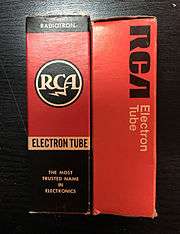
The Navy had installed a high-powered Alexanderson alternator, built by General Electric (GE), at the American Marconi transmitter site in New Brunswick, New Jersey. It proved to be superior for transatlantic transmissions to the spark transmitters that had been traditionally used by the Marconi companies. Marconi officials were so impressed by the capabilities of the Alexanderson alternators that they began making preparations to adopt them as their standard transmitters for international communication. A tentative plan made with General Electric proposed that over a two-year period the Marconi companies would purchase most of GE's alternator production. However, this proposal was met with disapproval, on national security grounds, by the U.S. Navy, which was concerned that this would guarantee British domination of international radio communication.[6]
The Navy, claiming it was acting with the support of President Wilson, looked for an alternative that would result in an "all-American" company taking over the American Marconi assets. In April 1919 two naval officers, Admiral H. G. Bullard and Commander S. C. Hooper, met with GE's president, Owen D. Young, asking that he suspend the pending alternator sales to the Marconi companies. This move would leave General Electric without a buyer for its transmitters, so the officers proposed that GE purchase American Marconi, and use the assets to form its own radio communications subsidiary. Young consented to this proposal, which, effective November 20, 1919, transformed American Marconi into the Radio Corporation of America.[6] The new company was promoted as being a patriotic gesture. RCA's incorporation papers required that its officers needed to be U.S. citizens, with a majority of its stock held by Americans.
RCA retained most of the American Marconi staff, although Owen Young became the new company's head as the chairman of the board. Former American Marconi vice president and general manager E. J. Nally become RCA's first president. Nally's term ended on December 31, 1922, and he was succeeded the next day by Major General James G. Harbord. Harbord in turn resigned the presidency on January 3, 1930, replacing Owen D. Young as the company's chairman of the board. He was succeeded, as RCA's third president, by David Sarnoff, who had been the company's general manager at its founding. RCA worked closely with the federal government, and felt it deserved to maintain its predominant role in U.S. radio communications. At the company's recommendation, President Woodrow Wilson appointed Rear Admiral Bullard "to attend the stockholders' and director's meetings... in order that he may present and discuss informally the Government's views and interests".[7]
As of its founding RCA was the largest radio communications firm in the United States.[8] American Marconi had been falling behind industry advances, particularly in vacuum tube technology, and GE needed access to additional patents before its new subsidiary could be fully competitive. The result was a series of negotiations and a complicated set of cross-licensing agreements between various companies. On July 1, 1920, an agreement was made with the American Telephone & Telegraph Company (AT&T), which purchased 500,000 shares of RCA, although it would divest these shares in early 1923. The United Fruit Company held a small portfolio of radio patents, and signed two agreements in 1921. GE's traditional electric company rival, the Westinghouse Electric & Manufacturing Corporation, had also purchased rights to some critical patents, including one for heterodyne receiving originally issued to Reginald Fessenden, plus regenerative circuit and superheterodyne receiver patents issued to Edwin Armstrong. Westinghouse used this position to negotiate a cross-licensing agreement, effective July 1, 1921, that included a concession that 40% of RCA's equipment purchases would be from Westinghouse. Following these transactions, GE owned 30.1% of RCA's stock, Westinghouse 20.6%, AT&T 10.3%, and United Fruit 4.1%, with the remaining 34.9% owned by individual shareholders.[9]
In 1930, RCA agreed to occupy the yet-to-be-constructed landmark building of the Rockefeller Center complex, 30 Rockefeller Plaza, which in 1933 became known as the RCA building (later renamed the GE Building, now the Comcast Building). This lease was critical for enabling the massive project to proceed as a commercially viable venture—David Rockefeller cited RCA's action as being responsible for "the salvation of the project".[10]
Radio development
International and marine communication
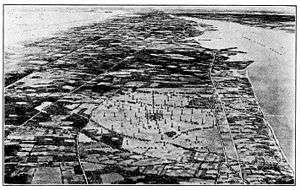

RCA's primary business objectives at its founding were to provide equipment and services for seagoing vessels, and "worldwide wireless" communication in competition with the undersea cables. To provide the international service, the company soon undertook a massive project to build a "Radio Central" communications hub at Rocky Point, Long Island, New York, designed to achieve "the realization of the vision of communication engineers to transmit messages to all points of the world from a single centrally located source". The circular Radio Central site encompassed 10 square miles (25 square kilometers), with a transmission building, located at the hub, projected to ultimately house ten Alexanderson alternator transmitters. The plan called for 12 "antenna spokes" to be built, stretching out in all directions from the center. Each spoke was nearly three miles (4.8 kilometers) long, and consisted of sixteen wires supported by a line of six 410-foot-tall (125 meter) towers topped with 150-foot-wide (45 meter) crossbars. Construction began in July 1920, and the site was dedicated on November 5, 1921, after two of the antenna spokes had been completed, and two of the 200-kilowatt alternators installed. The debut transmissions received replies from stations in 17 countries.[12]
Although the initial installation would remain in operation, the additional antenna spokes and alternator installations would not be completed, due to a major discovery about radio signal propagation. While investigating transmitter "harmonics" – unwanted additional radio signals produced at higher frequencies than a station's normal transmission frequency – Westinghouse's Frank Conrad unexpectedly found that in some cases the harmonics could be heard farther than the primary signal, something previously thought impossible, as high-frequency shortwave signals, which had poor groundwave coverage, were thought to have a very limited transmission range. In 1924, Conrad demonstrated to Sarnoff that a low-powered shortwave station in East Pittsburgh, Pennsylvania could be readily received in London by a simple receiver using a curtain rod as an antenna, matching, at a small fraction of the cost, the performance of the massive alternator transmitters. In 1926 Dr. Harold H. Beverage further reported that a shortwave signal, transmitted on a 15-meter wavelength (approximately 20 MHz), was received in South America more readily during the daytime than the 200 kilowatt alternator transmissions.[13]
The Alexanderson alternators, control of which had led to RCA's formation, were now considered obsolete, and international communication would be primarily conducted using vacuum tube transmitters operating on shortwave bands. RCA would continue to operate international telecommunications services for the remainder of its existence, through its subsidiary RCA Communications, Inc., and later the RCA Global Communications Company.
International shortwave was in turn largely supplanted by communications satellites, especially for distributing network radio and television programming. In 1975, the company formed RCA American Communications, which operated its Satcom series of geostationary communications satellites.
Broadcasting
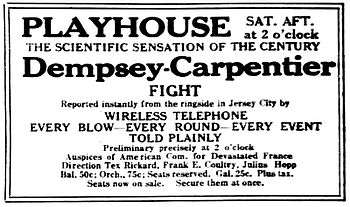
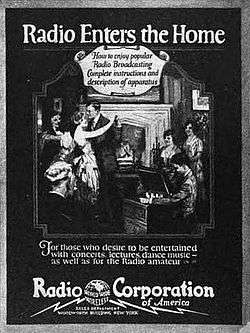
The introduction of organized radio broadcasting in the early 1920s resulted in a dramatic reorientation and expansion of RCA's business activities. The development of vacuum tube radio transmitters made audio transmissions practical, in contrast with the earlier transmitters which were limited to sending the dits-and-dahs of Morse code. Since at least 1916, when he was still at American Marconi, David Sarnoff had proposed establishing broadcasting stations, but his memos to management promoting the idea for sales of a "Radio Music Box" had not been followed up at the time.[14]
Starting around 1920 a small number of broadcasting stations began operating, and soon interest in the innovation was spreading nationwide. In the summer of 1921, a Madison Square Garden employee, Julius Hopp, devised a plan to raise charitable funds by broadcasting, from ringside, the July 2, 1921 Dempsey-Carpentier heavyweight championship fight to be held in Jersey City, New Jersey. Hopp recruited theaters and halls as listening locations that would charge admission fees to be used as charitable donations. He also contacted RCA's J. Andrew White, the acting president of the National Amateur Wireless Association (NAWA), an organization originally formed by American Marconi which had been inherited by RCA. White agreed to recruit the NAWA membership for volunteers to provide assistance at the listening sites, and also enlisted David Sarnoff for financial and technical support. RCA was authorized to set up a temporary longwave radio station, located in Hoboken a short distance from the match site, and operating under the call letters WJY. For the broadcast White and Sarnoff telephoned commentary from ringside, which was typed up and then read over the air by J. Owen Smith. The demonstration was a technical success, with a claimed audience of 300,000 listeners throughout the northeast.[15]
RCA quickly moved to expand its broadcasting activities. In the fall of 1921 it set up its first fulltme broadcasting station, WDY, at the Roselle Park, New Jersey company plant. By 1923 RCA was operating three stations—WJZ (now WABC) and WJY in New York City, and WRC (now WTEM) in Washington, D.C. A restriction imposed by AT&T's interpretation of the patent cross-licensing agreements required that the RCA stations remain commercial free, and they were financed by profits from radio equipment sales.
National Broadcasting Company
Beginning in 1922, AT&T became heavily involved in radio broadcasting, and soon became the new industry's most important participant. From the beginning AT&T's policy was to finance stations by commercial sponsorship of the programs. The company also created the first radio network, centered on its New York City station WEAF (now WFAN), using its long distance telephone lines to interconnect stations. This allowed them to economize by having multiple stations carry the same program.
RCA and its partners soon faced an economic crisis, as the costs of providing programming threatened to exceed the funds available from equipment profits. The problem was resolved in 1926 when AT&T unexpectedly decided to exit the radio broadcasting field. RCA purchased, for $1,000,000, AT&Ts two radio stations, WEAF and WCAP in Washington, D.C., as well as its network operations. These assets formed the core for the creation of the National Broadcasting Company (NBC), with ownership divided between RCA (50%), General Electric (30%), and Westinghouse (20%) until 1930, when RCA assumed 100% ownership. This purchase also included the right to begin commercial operations. NBC formed two radio networks that eventually expanded nationwide: the NBC-Red Network, with flagship station WEAF, and NBC-Blue, centered on WJZ. Although NBC was originally promoted as expecting to just break even economically, it soon became very profitable, which would be an important factor in helping RCA survive the economic pressures of the Great Depression that began in 1929.[16]
Concerned that NBC's control of two national radio networks gave it too much power over the industry, in 1941 the Federal Communications Commission (FCC) promulgated a rule designed to force NBC to divest one of them.[17] This order was upheld by the U.S Supreme Court, and on October 12, 1943, the NBC-Blue network was sold to candy magnate Edward J. Noble for $8,000,000, and renamed "The Blue Network, Inc." In 1946 the name was changed to the American Broadcasting Company. The "Red" network retained the NBC name, and remained under RCA ownership.
For two decades the NBC radio network's roster of stars provided ratings consistently surpassing those of its main competitor, the Columbia Broadcasting System (CBS). But in 1948, as the transition from radio to television was beginning, NBC's leadership came under attack due to what became known as the "Paley raids", named after the president of CBS, William S. Paley. After World War II the tax rate for annual incomes above $70,000 was 77%, while capital gains were taxed at 25%. Paley worked out an accounting technique whereby individual performers could set up corporations that allowed their earnings to be taxed at the significantly lower rate. Instead of NBC responding with a similar package, Sarnoff decided that this accounting method was legally and ethically wrong. NBC's performers did not agree, and most of the top stars, including Amos and Andy, Jack Benny, Red Skelton, Edgar Bergen, Burns and Allen, Ed Wynn, Fred Waring, Al Jolson, Groucho Marx and Frank Sinatra moved from NBC to CBS. As a result, in 1949 CBS now boasted of having sixteen of the twenty top rated programs. The consequences would carry over to television, where CBS maintained its newfound dominance for decades. Paley had personally worked to woo the performers, while Sarnoff professed his indifference to the defections, stating at an annual meeting that "Leadership built over the years on a foundation of solid service cannot be snatched overnight by buying a few high-priced comedians. Leadership is not a laughing matter."[18]
Radio receivers
RCA acted as the sales agent for a small line of Westinghouse and GE branded receivers and parts used by home constructors, originally for a limited market of amateur radio enthusiasts. By 1922, the rise of broadcasting had dramatically increased the demand for radio equipment by the general public, and this development was reflected in the title of RCA's June 1, 1922 catalog, "Radio Enters the Home". RCA began selling receivers under the "Radiola" name, marketing equipment produced by GE and Westinghouse under the production agreement that allocated a 60%–40% ratio in output between the two companies. Although the patent cross-licensing agreements had been intended to give the participants domination of equipment sales, the tremendous growth of the market led to fierce competition, and in 1925 RCA fell behind Atwater Kent as the leader in receiver sales. RCA was particularly hamstrung by the need to coordinate its sales within the limits of the GE/Westinghouse production quotas, and often had difficulty keeping up with industry trends. However, it made a key advance in early 1924 when it began to sell the first superheterodyne receivers, whose high level of performance increased the brand's reputation and popularity. Until late 1927 all the RCA receivers ran on batteries, but at that point plug-in AC sets were introduced, which provided another boost in sales.[19]
Vacuum tubes
RCA inherited American Marconi's status as a major producer of vacuum tubes, which were branded Radiotron in the United States. Especially after the rise of broadcasting, they were a major profit source for the company. RCA's strong patent position meant that the company effectively set the selling prices for vacuum tubes in the U.S., which were significantly higher than in Europe, where Lee de Forest had allowed a key patent issued to him to lapse. RCA was responsible for creating a series of innovative products, ranging from octal base metal tubes co-developed with General Electric before World War II, to miniaturized Nuvistor tubes used in the tuners of the New Vista series of TV sets. The Nuvistor tubes were a last major vacuum tube innovation, and were meant to compete with the newly introduced transistor. By 1975, RCA had completely switched from tubes to solid-state devices in their television sets, except for the cathode ray tube (CRT) picture tube.
Phonograph
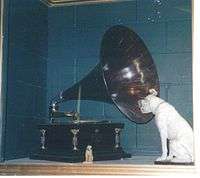
The rise of radio broadcasting during the early 1920s, which provided unlimited free home entertainment, caused significant financial problems throughout the established phonograph record industry. In 1929, RCA purchased the Victor Talking Machine Company, then the world's largest manufacturer of both records and phonographs, including its popular showcase "Victrola" line. This acquisition was organized as a new subsidiary called RCA Victor, and included majority ownership of the Victor Company of Japan (JVC).
With this purchase, RCA acquired the western hemisphere rights to the famous Nipper/"His Master's Voice" trademark.[21] RCA Victor popularized combined radio receiver-phonographs, and also created RCA Photophone, a movie sound-on-film system that competed with William Fox's sound-on-film Movietone and Warner Bros.' sound-on-disc Vitaphone. The acquisition of the Victor company also gave RCA superior distribution and manufacturing capability through Victor's established and extensive network of authorized dealers and newly acquired factories in Camden, New Jersey, which began manufacturing radio sets and components, in addition to Victrolas and records.[22]
RCA began selling the first all electric phonograph in 1930. In 1931, RCA Victor introduced 33⅓ revolutions-per-minute (rpm) records, which were a commercial failure during the Great Depression, partly because the records and playback equipment were very expensive, and also because the audio performance was generally poor; the new format used the same groove size as existing 78 rpm records,[23] and it would require the smaller-radius stylus of the later microgroove systems to achieve acceptable slower-speed performance.[24]
In 1932, during the nadir of the record business in America during the Great Depression, RCA Victor introduced the inexpensive Duo Jr. turntable designed to be plugged into radio sets.[25] Also during the 1930s, RCA sold the modernistic RCA Victor M Special, a polished aluminum portable record player designed by John Vassos that has become an icon of Thirties American industrial design.[26] In 1949, RCA Victor released the first 45 rpm "single" records, as a response to CBS/Columbia's successful introduction of its microgroove 33⅓ rpm "LP" format. RCA Victor began selling 33⅓ rpm LP records in 1950,[27][28] and in 1951 CBS/Columbia began selling 45 rpm records.[29]
Motion pictures
RCA also made investments in the movie industry, but they performed poorly. In April 1928 RCA Photophone, Inc., was organized by a group of companies including RCA to develop sound-movie technology. In the fall of 1927, RCA had purchased stock in Film Booking Office (FBO), and on October 25, 1928, with the help of Joseph P. Kennedy, the Radio-Keith-Orpheum Corporation (RKO) studio was formed by merging FBO with Keith-Albee-Orpheum Corporation (KAO), a company whose holdings included motion picture theaters. The theaters in which RKO had an interest provided a potential market for the RCA Photophone sound systems. RCA ownership of RKO stock expanded from approximately 25 percent in 1930 to approximately 61 percent in 1932.[30] However, the RKO studio was poorly run and encountered severe financial problems, going into receivership from early 1933 to 1940. RCA sold its holdings in order to raise funds for its basic operations.
Separation from General Electric
Following years of industry complaints that the cross-licensing agreements between RCA, GE and Westinghouse had in effect created spheres-of-influence for the participating companies, resulting in illegal monopolies, in May 1930 the U.S. Department of Justice brought antitrust charges against the three companies.[31] After a long period of negotiation, in 1932 the Justice Department accepted a consent agreement which removed the restrictions established by the cross-licensing agreements, and also provided that RCA would become a fully independent company. As a result, GE and Westinghouse gave up their ownership interests in RCA, while RCA was allowed to keep its factories.[32] In order to give RCA a chance to establish itself, GE and Westinghouse were required to refrain from competing in the radio business for the next two and one-half years.[33]
Television
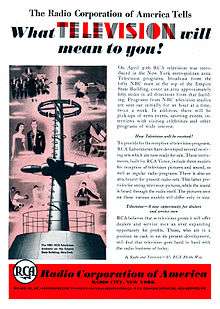
RCA began TV development in early 1929, after an overly optimistic Vladimir K. Zworykin convinced Sarnoff that a commercial version of his prototype system could be produced in a relatively short time for $100,000. Following what would actually be many years of additional research and millions of dollars, RCA demonstrated an all-electronic black-and-white television system at the 1939 New York World's Fair. RCA began regular experimental television broadcasting from the NBC studios to the New York metropolitan area on April 30, 1939 via station W2XBS, channel 1 (which evolved into WNBC channel 4) from a transmitter atop the Empire State Building. At the same time, RCA began selling its first television set models, including the TRK-5 and TRK-9, in various New York stores.[35] However, the FCC had not approved the start of commercial television operations, because technical standards had not been yet been finalized. Concerned that RCA's broadcasts were an attempt to flood the market with sets that would force it to adopt RCA's current technology, the FCC stepped in to limit its broadcasts.
Following the adoption of National Television System Committee (NTSC) recommended standards, the FCC authorized the start of commercial television broadcasts on July 1, 1941. The entry of the United States into World War II a few months later greatly slowed its deployment, but RCA resumed selling television receivers almost immediately after the war ended in 1945. (See also: History of television)
In 1950, the FCC adopted a standard for color television that had been promoted by CBS, but the effort soon failed, primarily because the color broadcasts could not be received by existing black-and-white sets. As the result of a major research push, RCA engineers developed a method of "compatible" color transmissions that, through the use of interlacing, simultaneously broadcast color and black-and-white images, which could be picked up by both color and existing black-and-white sets. In 1953, RCA's all-electronic color TV technology was adopted as the standard for American television. At that time, Sarnoff predicted annual color TV sales would reach 1.78 million in 1956, but the sets were expensive and difficult to adjust, and there was initially a lack of color programming, so sales lagged badly and the actual 1956 total would only be 120,000.[36] RCA's ownership of NBC proved to be a major benefit, as that network was instructed to promote its color programming offerings; even so, it was only in 1968 that color TV sales in the U.S. surpassed black-and-white.
While lauding the technical prowess of his engineers who had developed color TV, David Sarnoff, in marked contrast to William Paley of CBS, did not disguise his dislike for popular TV programs. His authorized biography even boasted that "no one has yet caught him in communion with one of the upper dozen or so top-rated programs" and "The popular programs, to put the matter bluntly, have very little appeal for him."[37]
RCA professional video cameras and studio gear, particularly of the TK-40/41 series, became standard equipment at many American television network affiliates, as RCA CT-100[38] ("RCA Merrill" to dealers) television sets introduced color television to the public.
Diversification
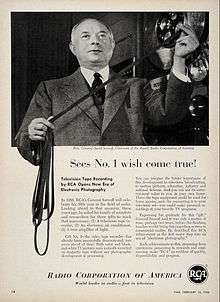
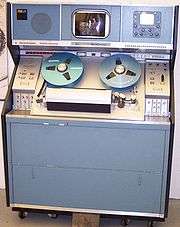
In 1941, a few months before the United States entered World War II, the cornerstone was laid for a research and development facility in Princeton, New Jersey called RCA Laboratories. Led for many years by Elmer Engstrom, it was used to develop many innovations, including color television, the electron microscope, CMOS-based technology, heterojunction physics, optoelectronic emitting devices, liquid crystal displays (LCDs), videocassette recorders, direct broadcast television, direct broadcast satellite systems and high-definition television.
During World War II, RCA was involved in radar and radio development in support of the war effort, and ranked 43rd among United States corporations in the value of wartime military production contracts.[40] During and after the war, RCA set up several new divisions for defense, space exploration and other activities. The RCA Service Corporation provided large numbers of staff for the Distant Early Warning (DEW) Line. RCA units won five Army–Navy "E" Awards for Excellence in production.[41] Also during the war, ties between RCA and JVC were severed.
In 1955, RCA sold its Estate large appliance operations to Whirlpool Corporation. As part of the transaction, Whirlpool was given the right to market "RCA Whirlpool" appliances through the mid-1960s.
RCA was one of a number of companies in the 1960s that entered the mainframe computer field in order to challenge the market leader International Business Machines (IBM) (see also: Computing). Although at this time computers were almost universally used for routine data processing and scientific research, in 1964 Sarnoff, who prided himself as a visionary, predicted that "The computer will become the hub of a vast network of remote data stations and information banks feeding into the machine at a transmission rate of a billion or more bits of information a second... Eventually, a global communications network handling voice, data and facsimile will instantly link man to machine—or machine to machine—by land, air, underwater, and space circuits. [The computer] will affect man's ways of thinking, his means of education, his relationship to his physical and social environment, and it will alter his ways of living. ... [Before the end of this century, these forces] will coalesce into what unquestionably will become the greatest adventure of the human mind."[42]
RCA marketed a Spectra 70 computer line that was hardware, but not software, compatible with IBM's System/360 series. It also produced the RCA Series, which competed against the IBM System/370.[43] This technology was leased to the English Electric company, which used it for their System 4 series, which were essentially RCA Spectra 70 clones. RCA's TSOS operating system was the first mainframe, demand paging, virtual memory operating system on the market. Despite significant investment, in 1971 RCA only had a 4% market share, and it was estimated that it would cost $500 million over the next five years to remain competitive with the IBM/370 series. On September 17, 1971 the RCA Board of Directors announced its decision to close its computer systems division (RCA-CSD), which would be written off as a $490 million company loss. Sperry Rand's UNIVAC division took over the RCA base in January 1972.
RCA Graphic Systems Division (GSD) was an early supplier of electronics designed for the printing and publishing industries. It contracted with German company Rudolf Hell to market adaptations of the Digiset photocomposition system as the Videocomp, and a Laser Color Scanner. The Videocomp was supported by a Spectra computer that ran the Page-1 and, later the Page-II and FileComp composition systems. RCA later sold the Videocomp rights to Information International Inc.
RCA became a major proponent of the eight-track tape cartridge, which it launched in 1965. The eight-track cartridge initially had a huge and profitable impact on the consumer marketplace. Sales of the 8-track tape format declined when consumers increasingly favored the 4-track compact cassette tape format developed by Philips.
Later years
On January 1, 1965, Robert Sarnoff succeeded his father as RCA's president, although the elder Sarnoff remained in control as chairman of the board. In 1969, the company name was changed from "Radio Corporation of America" to the "RCA Corporation", to reflect its broader range of corporate activities and expansion into other countries. At the end of that same year David Sarnoff, after being incapacitated by a long-term illness, was removed as the company's chairman of the board. He died two years later.
RCA's 1971 exit from the mainframe computer market marked a milestone in its transition from technology toward diversification as a business conglomerate. During the late 1960s and 1970s the company made a wide-ranging series of acquisitions, including Hertz (rental cars), Banquet (frozen foods and TV dinners), Coronet (carpeting), Random House (publishing) and Gibson (greeting cards). However, the company was slipping into financial disarray, with wags calling it "Rugs Chickens & Automobiles" to poke fun at its new direction.[44]
Robert Sarnoff's time as president was unsuccessful, marked by falling profits. He was ousted in a 1975 "boardroom coup" led by Anthony Conrad, who became the new company president. Conrad resigned less than a year later after he admitted failing to file income tax returns for six years. His successor, Edgar H. Griffiths, proved to be unpopular and retired in early 1981. Thornton Bradshaw would be the next, and last, RCA president.
RCA maintained its high standards of engineering excellence in broadcast engineering and satellite communications equipment, but ventures such as the NBC radio and television networks declined. Around 1980, RCA corporate strategy reported on moving manufacture of its television sets to Mexico. RCA was still profitable in 1983, when it switched manufacturing of its VHS VCRs from Panasonic to Hitachi.
Projects attempting to establish new consumer electronics products lost money. An RCA Studio II home video game console, introduced in 1977, was canceled just under two years later due to poor sales. A capacitance electronic (CED) videodisc, marketed under the SelectaVision name, was launched in 1981, but never developed the manufacturing volumes needed to substantially bring down its price, and was unable to compete against cheaper, recordable videotape technology. It was abandoned in 1985 for a write-off of several hundred million dollars.
In 1981, Columbia sold its share in the home video division to RCA and outside of North America this division was renamed to "RCA/Columbia Pictures International Video". The following year, within North America, it was renamed to "RCA/Columbia Pictures Home Video". In 1983, Arista Records owner Bertelsmann sold 50% of Arista to RCA. In 1985, Bertelsmann and RCA formed a joint venture called RCA/Ariola International, which took over management of RCA Records.[45]
In 1984, RCA Broadcast Systems Division moved from Camden, New Jersey, to the site of the RCA antenna engineering facility in Gibbsboro, New Jersey. On October 3, 1985, RCA announced it was closing the Broadcast Systems Division.[46] In the years that followed, the broadcast product lines developed in Camden were terminated or sold off, and most of the buildings at the Camden site were demolished, except for a few of the original RCA Victor buildings that had been declared national historic buildings.[47] For several years, RCA spinoff L-3 Communications Systems East was headquartered in the famous Nipper Building, but has since moved to an adjacent building built by the city for them. The Nipper Building now houses shops and luxury loft apartments.[48]
Re-acquisition and break-up by General Electric
In December 1985, it was announced that General Electric would reacquire its former subsidiary for $6.28 billion in cash, or $66.50 per share of stock.[49] The sale was completed the next year, and GE proceeded to sell off most of the RCA assets. (The only RCA unit which GE ultimately retained was Government Services.) GE disposed of its 50% interest in RCA Records to its partner Bertelsmann, and the company was renamed BMG Music, for Bertelsmann Music Group. In 1987, RCA Global Communications Inc., a division with roots dating back to RCA's founding, was sold to the MCI Communications Corporation.[50] The rights to make RCA and GE-branded televisions and other consumer electronics products were purchased in 1988 by the French company Thomson Consumer Electronics, in exchange for some of Thomson's medical businesses. (For information on the RCA brand after 1986, see RCA (trademark).) That same year, its semiconductor business (including the former RCA Solid State unit and Intersil) was bought by Harris Corporation.[51] In 1991, GE sold its share in RCA/Columbia to Sony Pictures which renamed the unit to "Columbia TriStar Home Video" (later further renamed to Columbia TriStar Home Entertainment, now Sony Pictures Home Entertainment). This merger surpassed the Capital Cities/ABC merger that happened earlier in 1985 as the largest non-oil merger in business history.[52]
Sarnoff Labs was put on a five-year plan whereby GE would fund all the labs' activities for the first year, then reduce its support to near zero after the fifth year. This required Sarnoff Labs to change its business model to become an industrial contract research facility. In 1988 it was transferred to SRI International (SRI) as the David Sarnoff Research Center, and subsequently renamed the Sarnoff Corporation. In January 2011 it was fully integrated into SRI.[53]
GE sold all of its radio station holdings to various owners, and the NBC Radio Network to Westwood One. In 2011, a controlling interest in the National Broadcasting Company, by this time part of the multimedia NBC Universal venture that included TV and cable, was sold by GE to Comcast, and in 2013, Comcast acquired the remaining interest.[54]
Legacy
RCA antique radios, and early color television receivers such as the RCA Merrill/CT-100, are among the more sought-after collectible radios and televisions, due to their popularity during the golden age of radio and the historic significance of the RCA name, as well as their styling, manufacturing quality and engineering innovations. Most collectable are the pre-war television sets manufactured by RCA beginning in 1939, including the TRK-5, TRK-9 and TRK-12 models.
The historic RCA Victor Building 17, the "Nipper Building", in Camden, New Jersey, was converted to luxury apartments in 2003.[55]
A type of plug/jack combination used in audio and video cables is still called the RCA connector.
To this day, a variety of consumer electronics including 2-in-1 tablets, televisions and telephones, home appliances and more are sold under the RCA brand name.
Environmental issues
Numerous former RCA manufacturing sites have been reported to be polluted with industrial waste.
- A former RCA facility in Taiwan's northern county of Taoyuan (now Taoyuan City) polluted groundwater with toxic chemicals and led to a high incidence of cancer among former employees.[56][57] The area was declared a toxic site by the Taiwanese Environmental Protection Agency. GE and Thomson spent millions of dollars for cleanup, removing 10,000 cubic yards (7,600 m3) of soil and installing municipal water treatment facilities for neighboring communities. A spokesman for RCA's current owners denied responsibility, saying a study conducted by the Taiwan government showed no correlation between the illnesses and the company's facilities, which shut down in 1991.[58] On April 17, 2015, RCA lost the case and the Taipei District Court ordered RCA's current owners to compensate its former employees with a total of NT$560 million (approximately USD18.1 million).[59]
- A plant in Lancaster, Pennsylvania which RCA operated from the late 1940s to June 1986, released more than 250,000 pounds of 1,1,1-trichloroethane pollutants per year from its exhaust stacks. Tests by the United States Environmental Protection Agency (EPA) in the late 1980s and early 1990s, found the groundwater contaminated by trichloroethylene (TCE) and 1,2-dichloroethylene (1,2-DCE).[60] In 1991 and 1992, contaminants were detected in monitoring wells on the east side of the Conestoga River in Lancaster.
- The shallow and deep groundwater aquifers beneath the Intersil Facility in Mountaintop, Pennsylvania, which RCA operated in the 1960s and later sold to Harris Corporation, were found in 1999 to contain elevated levels of volatile organic compounds.[61]
- A site in Burlington, Massachusetts which RCA used from 1958 to 1994 to make and test military electronics equipment, generated hazardous waste (VOCs, TCE, toluene, ethylbenzene, and xylenes).[62]
- In Barceloneta, Puerto Rico, an RCA-operated plant generated wastes containing chromium, selenium and iron. Four lagoons holding chemical waste drained into the limestone aquifer.[63][64] Used water from the manufacturing process (process water), containing ferric chloride, was treated onsite to remove contaminants and then was discharged into a sinkhole at the site. The treatment of process water created a sludge that was stored onsite in drying beds and in surface impoundments.[65]
Photo gallery
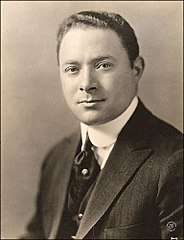 David Sarnoff in 1922
David Sarnoff in 1922 Edwin Armstrong at RCA
Edwin Armstrong at RCA RCA Nipper atop the old RCA distribution building, Broadway, Albany, New York
RCA Nipper atop the old RCA distribution building, Broadway, Albany, New York- RCA Nipper window in Camden NJ.
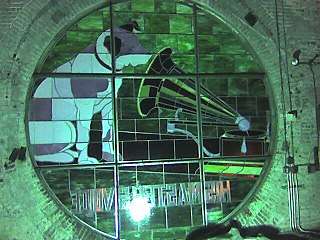 The Nipper stained glass atop the "Nipper Tower" in the former Building 17.[66]
The Nipper stained glass atop the "Nipper Tower" in the former Building 17.[66]- RCA Dimensia TV logo 1980s
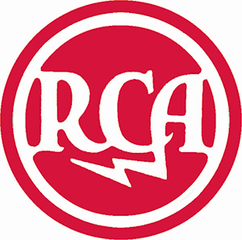 Early RCA logo. A later variation of this logo was revived by BMG after it bought RCA Records from GE, which is still used by Sony Music.
Early RCA logo. A later variation of this logo was revived by BMG after it bought RCA Records from GE, which is still used by Sony Music.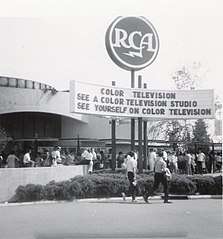 RCA Pavilion at the 1964 New York World's Fair
RCA Pavilion at the 1964 New York World's Fair.jpg)
 RCA Radio ad, circa 1945.
RCA Radio ad, circa 1945.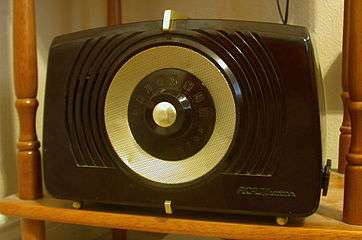 RCA Radio x551, Early '50s AC/DC tabletop radio
RCA Radio x551, Early '50s AC/DC tabletop radio- AR-88 communications receiver
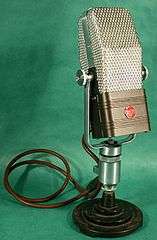 RCA 44-BX Bi-Directional Velocity Microphone.
RCA 44-BX Bi-Directional Velocity Microphone. Victor Talking Machine's His Master's Voice logo with Nipper (1921).
Victor Talking Machine's His Master's Voice logo with Nipper (1921).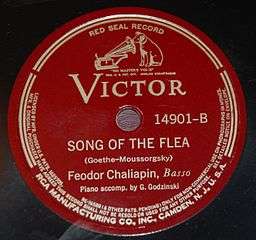 RCA Victor Red Seal Records label, 1930s
RCA Victor Red Seal Records label, 1930s- Arthur Fiedler demonstrates the new RCA Victor 45rpm player and record in February 1949.
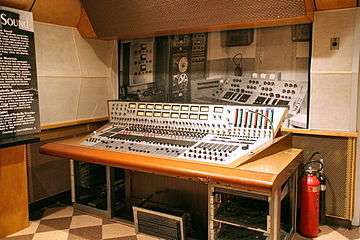 RCA Studio B recording studio in Nashville, Tennessee; known in the 1960s for being part of the Nashville sound.
RCA Studio B recording studio in Nashville, Tennessee; known in the 1960s for being part of the Nashville sound.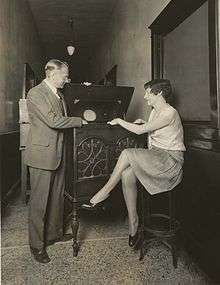 Vladimir K. Zworykin with an early experimental TV
Vladimir K. Zworykin with an early experimental TV- Grace Brandt and Eddie Albert in a 1936 NBC television program The Honeymooners-Grace and Eddie Show using an early RCA camera.
- Television test pattern created by RCA in 1939
%2C_Wolfsonian-FIU%2C_Miami%2C_Florida%2C_USA_-_20130910.jpg) First U.S. commercial TV set, the RCA Victor TRK 12 (1939)[67]
First U.S. commercial TV set, the RCA Victor TRK 12 (1939)[67] RCA 630-TS, the first mass-produced television set, sold in 1946–1947
RCA 630-TS, the first mass-produced television set, sold in 1946–1947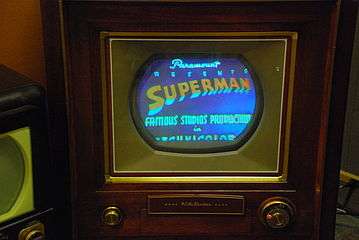 1954 RCA CT-100 TV[68]
1954 RCA CT-100 TV[68]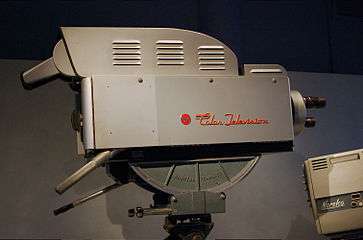 1954 RCA TK-41C dolly-mounted color broadcast camera
1954 RCA TK-41C dolly-mounted color broadcast camera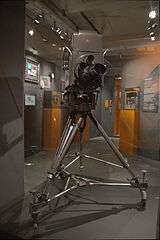 1954 RCA television camera
1954 RCA television camera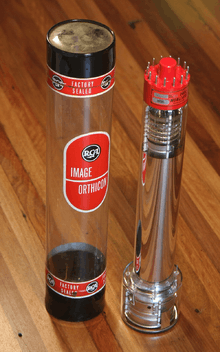 1970s-era RCA Radiotron Image Orthicon TV Camera Tube
1970s-era RCA Radiotron Image Orthicon TV Camera Tube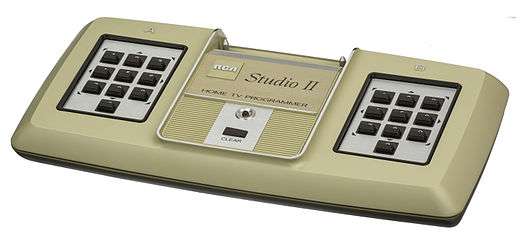 RCA Studio II home video game console (1977)
RCA Studio II home video game console (1977)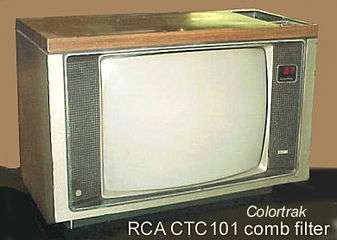 RCA Colortrak TV set, using the CTC101 chassis, c. 1980
RCA Colortrak TV set, using the CTC101 chassis, c. 1980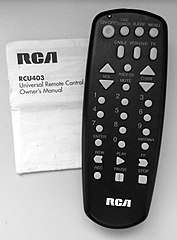 RCA Universal Remote RCU403, c. 2002-2003
RCA Universal Remote RCU403, c. 2002-2003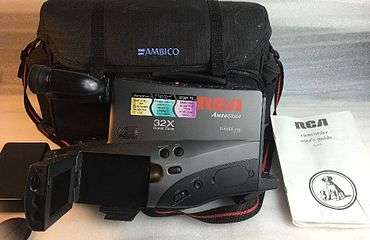 RCA AutoShot VHS Camcorder, c. 1998
RCA AutoShot VHS Camcorder, c. 1998 RCA connector used for audio and video.
RCA connector used for audio and video.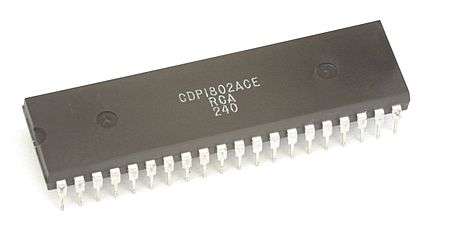
See also
- Ampliphase
- Berliner Gramophone Company, whose Canadian operation became RCA Victor of Canada
- Capacitance Electronic Disc format, marketed as RCA SelectaVision
- Claude Robinson, American pioneer in advertising and opinion survey research
- CMOS 4000 series
- Colortrak and Colortrak 2000, notable trademarks for RCA's early color television sets
- Dimensia, a high-end advanced trademark TV for RCA
- Edwin Howard Armstrong, Inventor and Radio Engineer working with RCA
- Electrofax
- Elmer T. Cunningham
- Empire State Building broadcast stations
- Ernst F. W. Alexanderson RCA's first Chief Engineer, 1920–1924
- Film Chain – RCA TK-26, TK-27 and TK-28
- George H. Brown, research engineer who headed RCA's development of color television
- Harold H. Beverage vice president of research and development at RCA Communications, Inc.
- HMV – His Master's Voice
- Victor Company of Japan (JVC)
- List of phonograph manufacturers
- Missile Test Project
- Professional video cameras – TK 47 and more
- RCA connector
- RCA Mark II Sound Synthesizer
- RCA Photophone, Motion Picture sound recording
- RCA Records
- RCA/Columbia Pictures Home Video, joint venture between RCA and Columbia Pictures
- RKO Pictures, founded in part by RCA
- Superette (radio) RCA trademark for their line of superheterodyne receivers during the early 1930s.
- Vladimir K. Zworykin Invented the Iconoscope image pickup tube for RCA early television camera video system.
- XL-100, RCA trademark for extended life and 100% solid state chassis on color television sets in the 1970s and later.
References
- ↑ "RCA (Radio Corporation of America)". IEEE Global History Network. IEEE. Retrieved 1 June 2017.
- ↑ Radio Corporation of America advertisement, The Wireless Age, August 1921, page 4.
- ↑ "A Marconi Wireless Telegraph Company for America", Electrical World and Engineer, December 2, 1899, pages 870–871.
- ↑ "Attempts to Establish a United States Government Radio Monopoly", History of Communications-Electronics in the United States Navy by Captain L. S. Howeth, USN (Retired), 1963, pages 313–318.
- ↑ "A New Wireless Chain Between the Americas" by John V. L. Hogan, Popular Science Monthly, November 1918, pages 140–143.
- 1 2 History of Radio to 1926 by Gleason L. Archer, 1938, pages 159–167, 180.
- ↑ Archer (1938), pages 187–188
- ↑ Page, Walter Hines; Page, Arthur W (May 1922). "The March Of Events: America in Control Of Its Wireless". The World's Work. XLIV: 11–13. Retrieved 1 June 2017.
- ↑ The Continuous Wave by Hugh G. J. Aitken, 1985, pages 445–447, 454–469, 477–481.
- ↑ "Rescuing the Project" section of Memoirs by David Rockefeller, New York: Random House, 2002, p. 55.
- ↑ The Book of Radio by Charles William Taussig, 1922, page 320.
- ↑ "The Opening of Radio Central", The Wireless Age, December 1921, pages 18–22, 45.
- ↑ Dr. Harold H. Beverage interview (hard-core-dx.com)
- ↑ Archer (1938), pages 112–113
- ↑ "Voice-Broadcasting the Stirring Progress of the 'Battle of the Century' ", The Wireless Age, August 1921, pages 11–21.
- ↑ "Early History of Network Broadcasting", Report on Chain Broadcasting: May, 1941, Federal Communications Commission, pages 5-8, 17.
- ↑ Rule 3.107, Report on Chain Broadcasting: May, 1941, Federal Communications Commission, page 92.
- ↑ The General by Kenneth Bilby, 1986, pages 246–249.
- ↑ Radio Manufacturers of the 1920s: Volume 3 by Alan Douglas, 1991, pages 1–60.
- ↑ RCA trademark exhibit at Heritage Museum in Big Spring, Texas (2004 photograph)
- ↑ The Nipper trademark was also used by the British music & entertainment company HMV.
- ↑ Hoag Levins (March 2009). "A Photo History of RCA's Golden Years in Camden". historiccamdencounty.com.
- ↑ Edward, David; et al. "RCA Program Transcription Album Discography (1931-33)". bsnpubs.com. Both Sides Now Publications. Retrieved August 19, 2015.
- ↑ A similar attempt the previous decade by Edison Records to market a commercial long play record format had also failed. The Edison approach used a microgroove vertically recorded disc with 20 minutes playing time per side.
- ↑ "Sound Recording".
- ↑ Dominic Muren, "Monday Masterpieces: Streamline+Vinyl=Awesome", IDFuel: Industrial Design Weblog, 2004. Accessed July 22, 2012
- ↑ Wallerstein, Edward. "LPs historic". musicinthemail.com. Retrieved 2017-06-01.
- ↑ "Diskery Goes 33 in March To Service Entire Market; 45 Promotion in High Gear". Billboard. 7 January 1950. Retrieved 1 June 2017.
- ↑ "Record Collector's Resource: A History of Records". cubby.net. Retrieved 2017-06-01.
- ↑ "RCA's interest in the motion-picture industry", Report on Chain Broadcasting: May, 1941, Federal Communications Commission, pages 13-14.
- ↑ "Government Starts Anti-Trust Suits", Gettysburg Times, May 14, 1930, page 2.
- ↑ "The Consent Decree", Big Business and Radio by Gleason L. Archer, 1939, pages 364-386.
- ↑ "RCA and Associates Separate Under Consent Decree Terms", Broadcasting, December 1, 1932, page 16.
- ↑ Radio & Television (magazine) Vol. X, No. 2, June, 1939. (inside front cover) New York: Popular Book Corporation.
- ↑ "Brochure for 1939 RCA TV sets". tvhistory.tv.
- ↑ Bilby (1986), pages 208, 213.
- ↑ David Sarnoff by Eugene Lyons, 1966, page 190.
- ↑ "CT-100 Color Receiver Gallery". Archived from the original on 2006-01-02.
- ↑ Based on a design originally developed by Ampex in the mid-1950s, it used a vertical scanning drum with head motion at 90° to tape direction. This method was developed prior to helical scanning, used in commercial and home tape machines.
- ↑ Peck, Merton J. & Scherer, Frederic M. The Weapons Acquisition Process: An Economic Analysis (1962) Harvard Business School p.619
- ↑ Radio Age by the Radio Corporation of America, p. 26
- ↑ Lyons (1966), page 339, from a speech delivered in October 1964 to the Joint Computer Conference in San Francisco.
- ↑ "RCA Spectra 70" (PDF). (computerhistory.org). March 1965. Retrieved 1 June 2017.
- ↑ Clausing, Don; Victor Fey (2004). Effective Innovation. New York: ASME Press. p. 7. Retrieved 25 February 2012.
- ↑ "RCA: Now Elvis rocked for Bertelsmann, too" (PDF). Bertelsmann Worldwide Media. Archived from the original (PDF) on 2013-02-15.
- ↑ "The History of Television, 1942 to 2000".
- ↑ "RCA TV Equipment Archive". oldradio.com.
- ↑ The Victor Lofts website, Camden, New Jersey. victorlofts.com
- ↑ "General Electric Will Buy RCA for $6.28 Billion" by Paul Richer, Los Angeles Times, December 12, 1985.
- ↑ "MCI Agrees to Acquire RCA Global From G.E." by Barnaby J. Feder, New York Times, September 4, 1987.
- ↑ "Company News; Harris Signs Accord To Buy a Unit of G.E." New York Times. November 9, 1988. Retrieved June 1, 2017.
- ↑ "General Electric Co., in the largest non-oil merger in..."
- ↑ "SRI International Completes Integration of Sarnoff Corporation" (Press release). SRI International. 2011-01-01. Retrieved 2017-06-01.
- ↑ Scott Mayerowitz (AP Business Writer) (12 February 2013). "General Electric gets out of the TV business".
- ↑ "RCA Victor Company, 'Nipper Building' Rehabilitation", New Jersey Historic Preservation Awards Program, 2004,.
- ↑ Yi, Matthew (May 24, 2002). "Taiwan workers plead cancer case / Link RCA plant to disease". San Francisco Chronicle. Hearst Communications. Retrieved 2014-09-23.
- ↑ Ton, 1999 Ton C-D, Exposure and Health Risk Assessment of Groundwater Contamination – A Case Study of Contamination Site of Tao-Yuan RCA. Master Thesis, National Taiwan University. 1999 (in Chinese)
- ↑ Silicon Valley Toxics Coalition Archived 2009-03-27 at the Wayback Machine.
- ↑ Chao, Stephanie (18 April 2015). "RCA parent firms to pay NT$560 mil". Retrieved 2015-07-05.
- ↑ EPA,OSWER,ORCR,PIID, US. "Corrective Action Programs around the Nation - US EPA" (PDF). US EPA.
- ↑ Intersil Corporation, S-1 SEC Filing, 11/10/1999
- ↑ SUPERFUND ANNUAL REPORT 2001. U.S. EPA Region I
- ↑ U.S. EPA, Environmental Quality Board, National Priority List (NPL), Site Inspection Report/Site Evaluation Report. EPA, San Juan Barceloneta RCA del Caribe, October 1987
- ↑ John M. Hunter and Sonia I. Arbona, "Paradise Lost: An Introduction to the Geography of Water Pollution in Puerto Rico", Soc. Sci. Med. Vol. 40, No. 10, pp. 1331–1355, 1995. Pergamon Press.
- ↑ 20058 - 20060 Federal Register / Vol. 70, No. 73 / Monday, April 18, 2005
- ↑ This photo is reversed from the normal orientation because it was taken from inside the "Nipper Tower". It shows the 2003 replacement of the 1979 replacement of the 1915 original glass.
- ↑ On display at the Wolfsonian–Florida International University center in Miami, Florida.
- ↑ Located at the American Museum of Radio And Electricity. The TV is playing an episode of the Superman television program.
Further reading
- Brewster, Richard (2013). "RCA TV Development: 1929–1949". The AWA Review. Antique Wireless Association. 26.
- Cowie, Jefferson (1999). Capital Moves: RCA's Seventy-Year Quest for Cheap Labor. Ithaca, New York: Cornell University Press. ISBN 0801435250.
- Sobel, Robert N. (1986). RCA. New York: Stein and Day. ISBN 0812830849.
- Taussig, Charles William (1922). "Radio Central". The Book of Radio. London: D. Appleton & Company. pp. 312–327. Retrieved 2014-09-23.
External links
| Wikimedia Commons has media related to RCA. |
- Official RCA trademark website
- Radio Corporation of American records (1887–1983) at Hagley Museum and Library.
- David Sarnoff Library Digital Collection at Hagley Museum and Library.
- RCA TV equipment archive (oldradio.com)
- Documents about RCA in the 20th Century Press Archives of the German National Library of Economics (ZBW)